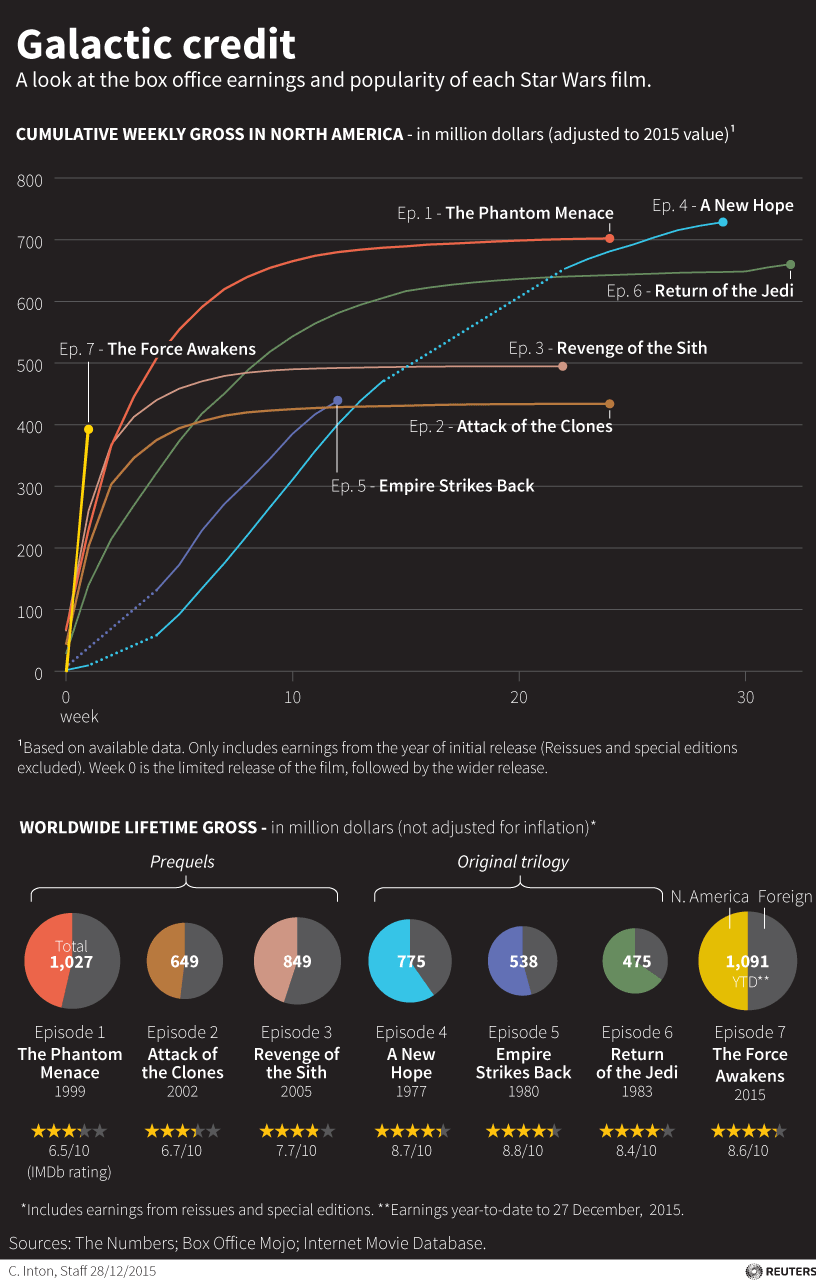"Star Wars: The Force Awakens" continues to break record after record at the box office, hitting $1 billion in just 12 days. But what do those box-office numbers actually mean in terms of revenue to Disney and theater chains?
The nearly $550 million the film has brought in in the U.S., and the additional $550 million from overseas theaters, does not translate directly to revenue to Disney; the studio has to split those ticket sales with theaters. But because "The Force Awakens" was so highly anticipated, Disney had massive leverage when it came to negotiating its deals with the theater chains — which are generally negotiated on a per movie basis.
Related: Star Wars: The Rise of a Financial Empire
Studios on average take about 55 cents of every dollar of tickets sold in the U.S. Eric Wold, analyst at B. Riley & Co., said the average has been 53 percent since 2008. But when it came to striking a deal for the new "Star Wars," Disney was able to secure more than 60 percent of ticket sales, sources told CNBC.
The split that theaters and studios negotiate generally slides over a film's lifespan. The studio gets a slightly bigger cut toward the beginning of a film's release, which then generally slides in favor of the theater over time. This is one reason studios are incentivized to spend big on advertising to get a huge opening weekend. For "The Force Awakens," Disney likely holds onto its bigger-than-usual piece of revenue throughout its run.

With the massive demand that was expected in advance of the film's release, Disney had the leverage to secure concessions from theaters. Studios usually require their films stay in theaters for three weeks, but Disney demanded a commitment of four weeks — and got it. Plus, Disney is ensuring that "The Force Awakens" plays in the biggest, most desirable rooms.
None of the theater chains would comment on Disney's unusual leverage to demand preferential terms for "The Force Awakens," but there's no question they all agreed to lower margins on tickets than usual.
Related: Why the Massive Success of ‘Star Wars’ Will Be Terrible for Movies
But that doesn't mean theaters are unhappy; "The Force Awakens" is still a massive win. Not only is the film drawing such hefty numbers of moviegoers that even at lower margins, theaters will end up in the black; perhaps more important, it's drawing massive audiences to spend big on higher-margin concessions.
And popcorn and soda are a significant part of theaters' revenue and an even bigger chunk of profit. In the third quarter concessions were 30 percent of Regal Cinemas', the largest theater chain. The margins for concessions are in the 85 to 95 percent range, Wold said.
"This is the type of film that will drive high traffic into a theater chain, and enable theater operators to sell high-margin concessions to those patrons," said Wold. "So even though you may not want to pay that high rate to a studio, it's worth it to get a film like this and drive that traffic.”
There's another way theaters will benefit: "Star Wars" is attracting many people who haven't been to a theater in a while to see trailers. Six years ago "Avatar" was credited for driving higher moviegoing attendance over the following three to six months. And this time around theaters may see an additional benefit — returning moviegoers will see all the investments theaters have been making in upgrades, from cocktail bars, to plush chairs that recline.
Related: The 10 Most Valuable Star Wars Figures
So why are theater stocks down this year? AMC and Regal, the two largest chains, have both fallen more than 10 percent. Wold said it's in part because of concerns that margin pressure on theaters' cuts of tickets will continue, without the upside of a film like "Star Wars" that brings the purchase of high-margin "Star Wars"-themed snacks.
So, why is the media so focused on that top-line box-office number if it means different things to studios with each film? True, the box-office numbers reported each week do not reflect profitability — they don't take into account the size of a film's budget or the tens of millions of dollars often spent on advertising. And the U.S. box office which the media so frequently focuses on, is a shrinking piece of the growing overall pie. (Splits with theaters are usually less preferential for studios overseas, though the splits vary country by country.)
But the U.S. box office can be used as an indicator of how big revenue from home entertainment will be, and the size of the box office often dictates the amount that cable TV channels like Starz and HBO have to pay studios to run a film. But mostly, it's a benchmark of U.S. demand. And without any consistent or reliable numbers on budget, and the amount studios spend on film and advertising, it'll likely remain the best number to at a glance indicate a brand's power to draw moviegoers out of their homes in an era of more competition for people's time and attention than ever.
This article originally appeared on CNBC. Read more from CNBC:
What to do with yout year-end bonus

